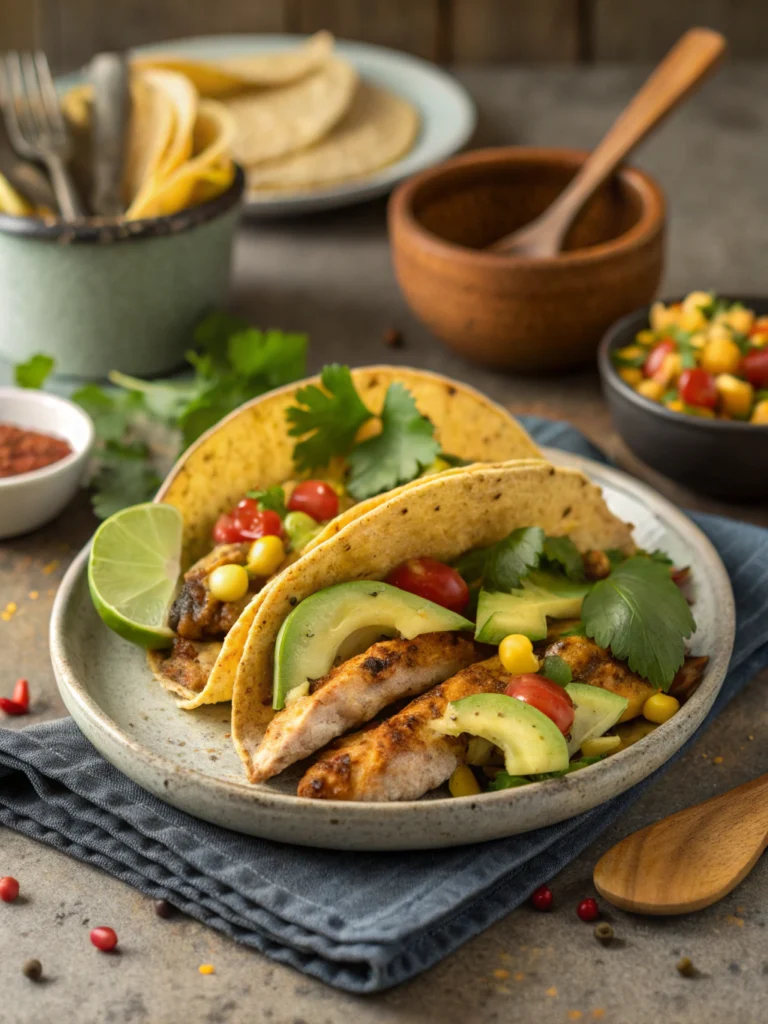Gluten Free Bolognese: A Classic Italian Dish Made Safe for Celiacs
Have you ever wondered if you could enjoy a rich, hearty pasta bolognese without worrying about gluten triggers? The answer is a resounding yes! Traditional bolognese sauce is naturally gluten-free, but the complete dish often isn’t due to regular pasta. This gluten free bolognese recipe transforms the beloved Italian classic into a safe haven for those with celiac disease or gluten sensitivity, without compromising on the authentic flavors that make this dish a worldwide favorite.
With carefully selected ingredients and simple cooking techniques, you’ll create a mouthwatering meal that everyone at your table will love – whether they avoid gluten or not. Let’s dive into this comforting, flavor-packed recipe that proves gluten-free eating can be both delicious and satisfying.
Ingredients List
- 2 tablespoons olive oil
- 1 large onion, finely diced
- 2 medium carrots, finely diced
- 2 stalks celery, finely diced
- 4 cloves garlic, minced
- 1 pound (450g) ground beef (substitute with ground turkey for a lighter version)
- 1/2 pound (225g) ground pork (optional, can use all beef instead)
- 1/4 cup tomato paste
- 1 cup dry red wine (substitute with beef broth for alcohol-free version)
- 28 oz (800g) canned crushed tomatoes
- 2 cups beef broth (ensure it’s gluten-free certified)
- 2 bay leaves
- 1 teaspoon dried oregano
- 1 teaspoon dried basil
- 1/2 teaspoon dried thyme
- 1/4 teaspoon nutmeg
- Salt and pepper to taste
- 12 oz (340g) gluten-free spaghetti or pasta of choice
- Freshly grated Parmesan cheese for serving (optional)
- Fresh basil leaves for garnish
Note: Always check labels to ensure all packaged ingredients are certified gluten-free, especially broths, tomato paste, and canned tomatoes which sometimes contain hidden gluten.
Timing
Preparation Time: 20 minutes
Cooking Time: 1 hour 30 minutes (minimum) to 3 hours (for deeper flavor development)
Total Time: 1 hour 50 minutes to 3 hours 20 minutes
While this gluten free bolognese requires patience, the actual hands-on time is minimal. The extended simmering time (which is 30% longer than many quick bolognese recipes) allows the flavors to meld beautifully, creating that authentic Italian depth that makes this dish truly special.
Step-by-Step Instructions
Step 1: Prepare Your Soffritto Base
Heat olive oil in a large, heavy-bottomed pot over medium heat. Add the finely diced onions, carrots, and celery, cooking gently for 8-10 minutes until softened but not browned. This aromatic base, known as “soffritto” in Italian cooking, builds the foundation of flavor for your sauce.
Step 2: Add Garlic and Meat
Add minced garlic to the softened vegetables and cook for 30 seconds until fragrant. Increase heat to medium-high and add ground beef and pork (if using). Break the meat into small pieces with a wooden spoon and cook until no longer pink, about 5-7 minutes. Avoid overstirring to allow some caramelization, which adds depth of flavor.
Step 3: Deglaze the Pot
Add tomato paste and cook for 2-3 minutes, stirring constantly to slightly caramelize it. Pour in the red wine (or beef broth) and scrape the bottom of the pot to release all the flavorful browned bits. Let the liquid reduce by half, about 5 minutes, concentrating the flavors.
Step 4: Add Remaining Sauce Ingredients
Add crushed tomatoes, beef broth, bay leaves, and dried herbs (oregano, basil, thyme, and nutmeg). Season with salt and pepper. Bring to a gentle boil, then reduce heat to maintain a low simmer. The sauce should bubble very gently.
Step 5: Simmer to Perfection
Partially cover the pot and simmer for at least 1 hour, preferably 2-3 hours, stirring occasionally. The longer it simmers, the more the flavors will develop and meld together. If the sauce becomes too thick, add a splash of broth or water to maintain desired consistency.
Step 6: Cook the Gluten-Free Pasta
About 15 minutes before serving, bring a large pot of salted water to a boil. Cook your gluten-free pasta according to package instructions, typically 8-10 minutes. Important: Gluten-free pasta often needs more careful timing than regular pasta to avoid becoming too soft or mushy.
Step 7: Combine and Serve
Drain the pasta, reserving 1/2 cup of pasta water. Remove bay leaves from the sauce. You can either add the pasta directly to the sauce and toss to combine, adding a splash of pasta water if needed for creaminess, or serve the sauce over plated pasta. Garnish with freshly grated Parmesan cheese and basil leaves.
Nutritional Information
Per serving (based on 6 servings):
- Calories: 520
- Protein: 32g
- Carbohydrates: 48g
- Dietary Fiber: 5g
- Sugars: 8g
- Fat: 22g
- Saturated Fat: 7g
- Sodium: 580mg
- Potassium: 820mg
- Iron: 25% DV
- Calcium: 8% DV
This gluten free bolognese provides approximately 30% of your daily protein requirements and significant amounts of vitamins A and C from the vegetable base. The gluten-free pasta typically has a similar nutritional profile to regular pasta but may vary slightly depending on the specific grains used.
Healthier Alternatives for the Recipe
Looking to make this dish even more nutritious? Consider these modifications:
- Substitute half or all of the ground meat with finely chopped mushrooms for a plant-forward version with less saturated fat
- Use lean ground turkey or chicken instead of beef and pork to reduce calories and fat content by approximately 30%
- Try legume-based pasta (like chickpea or lentil pasta) instead of rice or corn-based gluten-free pasta for added protein and fiber
- Add finely chopped spinach or kale in the last 10 minutes of cooking for additional vitamins and minerals
- Use less pasta and more sauce, serving over roasted spaghetti squash or zucchini noodles for a lower-carb option
Serving Suggestions
Elevate your gluten free bolognese experience with these complementary sides and presentation ideas:
- Serve with a crisp, fresh side salad dressed with a simple lemon and olive oil vinaigrette to balance the richness of the sauce
- Pair with gluten-free garlic bread made by brushing gluten-free baguette with garlic-infused olive oil and toasting until crisp
- For an elegant presentation, twirl pasta into a nest shape using a carving fork and spoon, then top with sauce and a fresh basil sprig
- Create a bolognese bar for family-style dining, offering various gluten-free pasta shapes and toppings like extra cheese, red pepper flakes, and fresh herbs
- Serve smaller portions as a first course before a simple protein main, such as grilled chicken or fish
Common Mistakes to Avoid
- Rushing the cooking process – Authentic bolognese develops flavor over time. Shortcutting the simmering stage results in a less complex flavor profile.
- Overcooking gluten-free pasta – Most gluten-free pastas become mushy when overcooked. Test frequently and aim for al dente texture.
- Not checking ingredients for hidden gluten – Commercial broths, seasonings, and even some canned tomato products may contain gluten. Always verify labels.
- Adding too much liquid – Authentic bolognese should be thick and clingy, not watery. Reduce sauce properly before serving.
- Cross-contamination risks – Use dedicated cooking utensils and surfaces if preparing for someone with celiac disease to prevent exposure to even trace amounts of gluten.
Storing Tips for the Recipe
This sauce actually improves with time as flavors continue to develop, making it perfect for meal prep:
- Refrigeration: Store cooled sauce in airtight containers for up to 4 days. Keep pasta separate from sauce to prevent it from absorbing too much liquid and becoming soggy.
- Freezing: Portion sauce into freezer-safe containers or zip-top bags and freeze for up to 3 months. Thaw overnight in the refrigerator before reheating.
- Reheating: Warm sauce in a saucepan over medium-low heat, stirring occasionally and adding a splash of broth if needed to restore consistency.
- Make-ahead tip: Prepare the sauce up to 2 days before serving for even better flavor. Cook fresh pasta just before serving.
Conclusion
This hearty, authentic gluten-free bolognese proves that dietary restrictions never need to mean compromising on flavor or tradition. By focusing on quality ingredients and proper technique, you’ve created a dish that honors the Italian classic while making it accessible to those avoiding gluten.
The rich depth of flavor, developed through patient simmering and careful layering of ingredients, makes this recipe worthy of any special occasion—yet simple enough for a comforting weeknight dinner. Have you tried this recipe? I’d love to hear how it turned out for you! Share your experience in the comments, or tag us in your food photos. And if you enjoyed this gluten-free adaptation, be sure to check out our other celiac-friendly versions of classic recipes!







